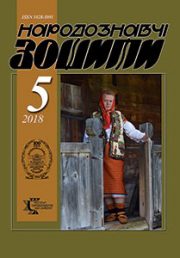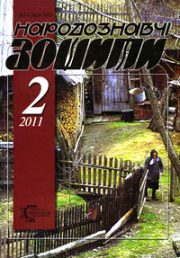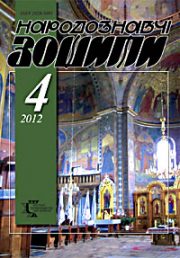The Ethnology Notebooks. 2019, 2 (146), 354—367
UDK 39:72.012:[643(=161.2:477.86-11)]”17/195″
DOI https://doi.org/10.15407/nz2019.02.354
FEATURES OF DEVELOPMENT IN PLANNING STRUCTURE OF POLISSYA DWELLING (18th — MID 20th CENTURY)
RADOVYCH Roman
ORCID ID: http://orcid.org/0000-0002-1900-8948
Doctor of Sciences in History, Senior Researcher
of the Institute of Ethnology
of the National Academy of Sciences of Ukraine,
in the Department of Historical Ethnology,
Svobody Avenue 15, 79000, Lviv, Ukraine
Contacts: radovychroman@gmail.com
Abstract. Horizontal planning is one of the main features of the historic dwelling typology. The development of the planning structure of housing in various regions of Ukraine was complex and diverse, as a result of a number of factors. Therefore, the elucidation of the local specificity of the planning structure of the settlements of certain ethnographic regions is very relevant today. The goal of author is to find out the peculiarities in formation of the planning structure of dwellings in Pokuttya and to reveal their common Ukrainian features and local specifics. The object of research is the traditional habitation of Pokutians, and the subject is its planning structure. Methodological basis of the research is the principle of historicism in combination with the elements of structural and functional analysis and the use of basic methods of ethnological science. Planning of the inhabitants of Pokutian people has never been the subject of special research. In the few publications concerning the housing and construction culture in this area, this aspect is covered by the authors rather quickly, without proper analysis, therefore the author’s field materials are the basis of the work.
Pokuttya housing, as well as the Ukrainian general, was formed on the basis of one-chamber heating. In 18th — in the first half of the 19th century there were two- (living room + passage) and three-chambered buildings (living room + passage + storeroom). There were also no rarities in the dwelling, in which the living space was located between the houses and storeroom (зфііфпу + living room + storeroom) at the Pokuttya-Boykivsk borderland at this time. Dwelling with two livingrooms, located on either side of the passage, are becoming increasingly popular in the middle of the 19th century. Such structures are becoming more widespread at the end of the nineteenth and early twentieth centuries. Moreover, in some areas, this type of planning becomes predominant. Storeroom in such cases are located at the back wall of the passage or at the one of the living quarters (in some cases, they are built separately). A small storeroom located in the passage became so commonplace that such premises sometimes even began to be allocated even in homes, which included a complete storeroom at the beginning of the 20th century. Comparison of the individual components of the planning structure (the specifics of the location of the premises, windows and doorways, the presence of annexes, etc.) makes it possible to state that the planning features of the settlements were formed under the influence of neighboring ethnographic regions: on the one hand, Podillya and Opilia, on the other — Hutsulshchyna (and partly Boykivshchyna). Actually due to these influences, their complex interweaving and rethinking, adaptation to local conditions, and created a specific planning option, which can be defined as Pokutskuy.
Keywords: Pokuttya, dwelling, planning, living room, passage, storehouse, annex.
Received 21.01.2019
REFERENCES
Hratsianska, N.N., Listova, N.M., & Tokarev, S.A. (1968). Introduction. Typology of people’s dwellings in countries of foreign Europe. In Types of rural dwellings in countries of foreign Europe (pp. 3—11). Moscow: Science [In Russian].
Blomkvist, E.E. (1956). Peasant buildings of Russians, Ukrainians and Belorussians: (settlements, dwellings and economic structures). In East Slavic ethnographic collection: Essays on folk material culture of Russians, Ukrainians and Belarusians in the 19 — early 20 centuries (pp. 3—458). Moscow: Publishing House of the Academy of Sciences of the USSR [In Russian].
Kosmyna, T. (1999). Settlement, mansion, housing. In Ukrainian: historical and ethnographic monography in two books (Vol. 2, pp. 13—57). Opishne: Ukrainian Genre Studies [In Ukrainian].
Radoviych, R. (2017). Pokuttya traditional accommodation: technique and technology of wall construction (19th — first half of 20th centuries). Plisnensky antiquities, 2, 27—61 [In Ukrainian].
Kolberg, O. (1882). Penetration: ethnographic picture (Vol. 1). Krakow: In the printing house of the Jagellonian university [in Polish].
Mroczko, Fr. X. (1897). Њnatyсszczyzna (Part 1). Lviv: From the printing house of Wіadysіaw Јoziсski [in Polish].
Wajgel, L. (1877). Drawing of the city of Kolomyia. Kolomyia: Print HZadembskiego ispуlki [in Polish].
Derkach, I., & Pankov, M. (1994). Manor on Pokuttya (end of the XIX — early XX century). Ivano-Frankivsk [In Ukrainian].
Yakymovych, A. (1998). Traditional folk dwelling of Pokuttya of the late nineteenth and early twentieth centuries. Proceedings. Museum of Folk Architecture and Life in Lviv, I, 58—63 [In Ukrainian].
Yakymovych, A.I. Report on the scientific expedition to Pokuttya; 7.06 — 15.06.1978. In The Archive of LMNAP. F. Materials of expeditions. Exp. ЗВ—11. 45 arcs. [In Ukrainian].
Yakymovych A. I. Report on the scientific expedition to Pokuttya; 17.06 — 25.06.1976. In The Archive of LMNAP. F. Materials of expeditions. Exp. ЗВ—17. 41 arcs. [In Ukrainian].
Yakymovych A.I. Report on the scientific expedition to Pokuttya; 17.06 — 25.06.1976 Supplements to ЗВ-17. T. 1. Album of photographs and sketches. In The Archive of LMNAP. F. Materials of expeditions. Exp. ЗВ—15. 68 arcs. [In Ukrainian].
Yakymovych A.I. Report on the scientific expedition to Pokuttya. 1984. In The Archive of LMNAP. F. Materials of expeditions. Exp. ЗВ—53. 24 arcs. [In Ukrainian].
Encyclopedia of agriculture. (1874). Warsaw [In Polish].
Falkowski, J. (1938). The north-eastern border of the Hutsul region. Ethnographic work, 4. Lviv: Publisher of the Folklore Society in Lviv [In Polish].
Goshko, Y.G. (1976). The population of the Ukrainian Carpathians of the 15th—18th centuries. Settlement. Migration Everyday life. Kiev: Scientific Opinion [In Ukrainian].
Mohitich, I.R. (1987). Types and development of the buildings of the peasant yard. In The folk architecture of the Ukrainian Carpathians of the 15th—20th centuries. (pp. 29—68). Kiev: Scientific Opinion [In Ukrainian].
Siletskuy, R. (1994). Rural settlement and farmstead in the Carpathians of the 19th—20th century. Kiev: Scientific Opinion [In Ukrainian].
Gratian, N.N. (1973). The typology of the traditional folk dwelling in the Ukrainian Carpathians in the nineteenth and early twentieth centuries (in connection with the preparation of the historical-geographical atlas of Ukraine, Byelorussia, Moldavia). Soviet ethnography, 4, 30—42 [In Russian].
Cosmina, T.V. (1980). Rural habitation of Podillya (end of 19 — 20 centuries): Historical and ethnographic research. Kiev: Scientific Opinion [In Ukrainian].
Radovych, R. (1996). Rural housing of the late 19 — early 20 centuries in the south of Podillya (based on materials from Borshchiv district). Chronicle of Borshchivschyna: Historical and Local Studies Collection, Issue VІІІ, 58—66. Borschiv: Source [In Ukrainian].
Vovk, H.V. (1995). Marriage ritual and ceremonies in Ukraine. Anthropology. In Vovk, H.V. Studies on Ukrainian ethnography and anthropology (pp. 19—323). Kiev: Art [In Ukrainian].
Zdorova, N.I. (1974). Essays on folk wedding ceremonies in Ukraine. Kiev [In Ukrainian].
Radovych, R. (1917). Heating system of people’s homes Pokuttya (19 — first half of 20 centuries). The Ethnology Notebooks, 1, 100—113 [In Ukrainian].
Radovych, R. (1995). Traditional rural housing in Opil in the second half of the 19 — early 20 centuries. In The Notes of the NTSh (Vol. SSChH, pp. 79—106). Lviv: NTSh [In Ukrainian].
Rusov, M. (1915). Types of rural villages in the midday part of Galicia. In The Collection of the Natural and Technical Section of the Ukrainian Scientific Society in Kyiv (pp. 77—221). Kiev [In Ukrainian].
Radovych, R. (1992). Features of people’s housing in the southwestern part of Volhynia (second half of the nineteenth and early twentieth centuries). In The Notes of the NTSh (Vol. SXHIII, pp. 95—104). Lviv: NTSh [In Ukrainian].
Tkach, V. (1911). Essays of the Kholmshchyna and Pidlyashcha Hill [In Russian].
Radovych, R. (1997). Folk Housing. In Kholmshchyna and Pidlyashcha: historical and ethnographic research (pp. 116—133). Kyiv: Rodovid [In Ukrainian].
Hurkov, V.S., & Hoshko, R.Y. (1988). Settlements In Polesie. Material culture (pp. 279—333). Kiev: Scientific Opinion [In Ukrainian].







